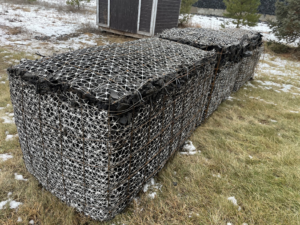Packaging Tire Derived Aggregate
Innovation was heard throughout the recent 2024 Tire Recycling Conference in Atlanta, Georgia. Not surprising, when for the first time, technology, compounding, and chemistry rather than tire processing took center stage.
Noteworthy, however, is innovation taking place in tire derived aggregate (TDA) that is adding value and bringing out its environmental benefits. Innovation that holds the promise of growing the use of this beneficial material and marrying its benefits with other construction materials in building and maintaining a sustainable infrastructure, managing stormwater and containing contaminants.
Not new, TDA has had a long list of benefits since its inception. It has ASTM standards. It’s been tested, studied, demonstrated and gained recognition as an engineering material.
Now those efforts are being realized, TDA pioneer, expert and end user, Monte Niemi said.
“While in Atlanta I went on a tour of the RAY, an eighteen mile stretch of I-85 in Georgia that will be the first net zero highway in the U.S. and is a living lab for innovative ideas and technologies” Niemi said.
We had the opportunity to see the area where they used rubberized asphalt, one of twelve different sustainable research projects that the RAY has helped to test and evaluate to fit our future circular economy. Their sustainable history on the RAY is truly amazing.
 With recycled rubber asphalt already in the Ray’s infrastructure, the Ray has expressed interest in testing TDA and its products, including TDA Blocks in up to five stormwater management scenarios. These tests aim to document the variety and percentage of contaminant removal achieved by TDA products.
With recycled rubber asphalt already in the Ray’s infrastructure, the Ray has expressed interest in testing TDA and its products, including TDA Blocks in up to five stormwater management scenarios. These tests aim to document the variety and percentage of contaminant removal achieved by TDA products.
Extensive research conducted by the University of Minnesota has focused on the water-cleaning attributes of TDA. The studies evaluated the release of three types of metals from TDA and the beneficial effects of the biofilm that grows on TDA. This biofilm effectively consumes these dissolved metals while achieving over 95 percent efficiency in removing dissolved phosphorus. The conclusive findings from this research have guided the development of user-friendly packaging for TDA.
Grant funding from a Market Development Grant from the Michigan Department of Environment, Great Lakes, and Energy (EGLE) Program, plays a large role in producing packaged TDA products and helping them get into testing and the open marketplace, Niemi said.
In May 2021, at its Michigan manufacturing location, I DO TDA received a Market Development Grant from the EGLE program. This grant aims to create demand for Michigan end-of-life tires by enhancing the packaging and developing a specialized product line of high value uses for TDA manufactured in Michigan, making these new products more user-friendly and easier to integrate into various designs and construction projects.
Based on the positive research results and supported by grant funding I DO TDA Inc. continues to explore and improve design methods and packaging material for the blocks. Among the criteria, the TDA blocks can be easily installed and used primarily for stormwater management and contaminate mitigation. TDA Blocks can also be placed under porous pavement to address surface water concerns. In this application, the blocks are installed in the sub-grade stormwater treatment reservoir. The first demonstration project involving TDA Blocks covered with Porous Pave surfacing is being installed this month.
The blocks serve as an effective phosphorus contaminant control device within the water treatment chain. Their compact design and ease of installation offer a practical solution for enhancing stormwater management systems.
These design and packaging advancements make the blocks readily available creating a new tool for stormwater engineers, Niemi said.
In addition to stormwater management, TDA is being utilized in construction projects to improve ground stability and insulation. A notable project in Pine City, Minnesota involves the use of TDA as a frost-free rubber corduroy underlayment material for a quarter-mile-long access road. Additionally, TDA is being used to build a frost-free stable building pad for a shop facility on the same site. The project covers about 6,000 cubic yards and will use 360,000 end of life tires.
© Scrap Tire News, July 2024






